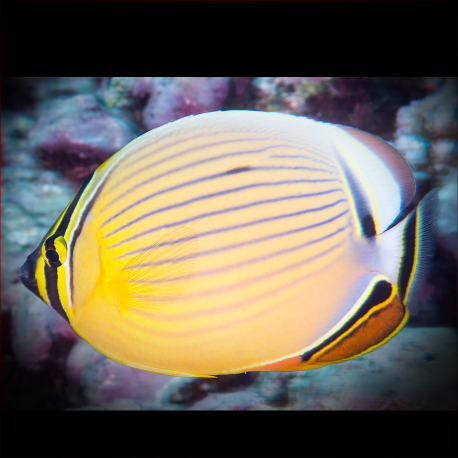More info
Datasheet
| Minimum Tank Size | 500 litres / 132.09 US gallons |
| Maximum Size | 14.0cm / 5.51inches |
| Reef Compatible | Not reef safe |
| Temperament | Mostly peaceful but might be aggressive towards similar species |
| Temperature | 22.2°C / 71.96°F - 25.6°C / 78.08°F |
| Specific Gravity | 1.020-1.025 |
| Carbonate Hardness | 8-12 |
| pH | 8.1-8.4 |
General Description
The Oval Butterflyfish, scientifically known as Chaetodon lunulatus, is part of the Chaetodontidae family, recognized for their vibrant patterns and colors. These fish lack the spines found on Angelfish, closely related species. They belong to a group of similarly looking species known as a "complex," with distinctions that are crucial for understanding their care requirements.
Aquarium Suitability
Considered unsuitable for home aquariums due to their specialized diet of mainly coral polyps, the Oval Butterflyfish will not survive on replacement foods. They are part of the Chaetodon genus complex, members of which have varying needs, making it vital to understand the specific requirements of each species within the group.
Demands, Care, and Hardiness
With an average hardiness level, the Oval Butterflyfish requires a large tank of at least 500 liters with ample swimming space. They thrive when provided with good hiding spots among live rocks for shelter. Acclimatizing them to aquarium life can be challenging, necessitating the purchase of healthy specimens free from parasites or infections.
Reef Suitability
Not considered reef safe, the Oval Butterflyfish poses a threat to coral reefs as they primarily feed on coral polyps. Their diet preference limits their compatibility with reef environments, making them unsuitable for reef tanks.
Aquarium Setup
For an aquarium housing Oval Butterflyfish, it is essential to recreate their natural habitat. Provide hiding spaces among live rocks while ensuring sufficient open swimming areas. Maintaining water conditions with pH levels between 8.1-8.4, temperatures of 22.2-25.6°C, and specific gravity ranging from 1.020-1.025 is crucial for their well-being.
Behaviour
Being mostly peaceful, Oval Butterflyfish generally coexist well with other tank mates. However, they may display aggression towards similar species, especially when not in pairs. Care should be taken when housing them alongside other butterflyfish in the same aquarium.
Feeding and Diet
This species predominantly feeds on small polyp stone corals (SPS). Due to their specialized diet, providing suitable live coral polyps is essential for their long-term survival. Encouraging captive-bred specimens that have adapted to eating frozen foods might offer an alternative for sustaining them in captivity.
Dimorphism and Captive Reproduction
Oval Butterflyfish can be bred in captivity, offering a potential source of captive-bred specimens for aquarium enthusiasts interested in keeping them. Special care and attention are required during breeding to ensure successful reproduction and sustainable populations.
Habitat and Distribution
Found across the Pacific Ocean, from Japan and Australia to the Tuamoto Islands and Hawaii, the Oval Butterflyfish inhabits coral-rich environments. In the Indian Ocean, they are replaced by Chaetodon trifasciatus. Understanding their natural habitat and distribution is crucial for recreating a suitable environment in captivity.

